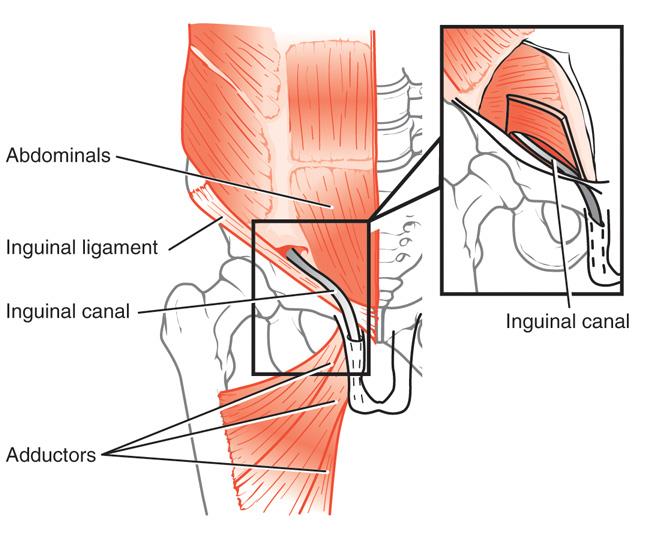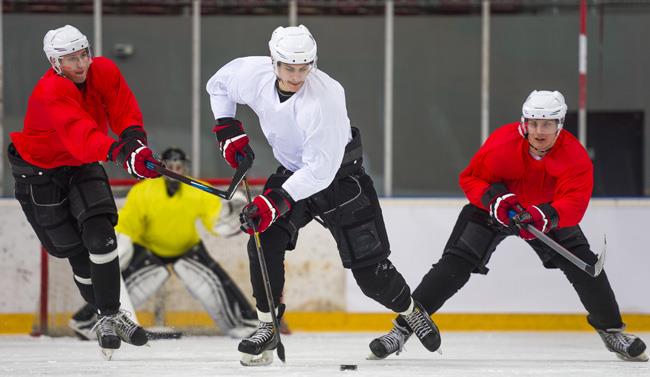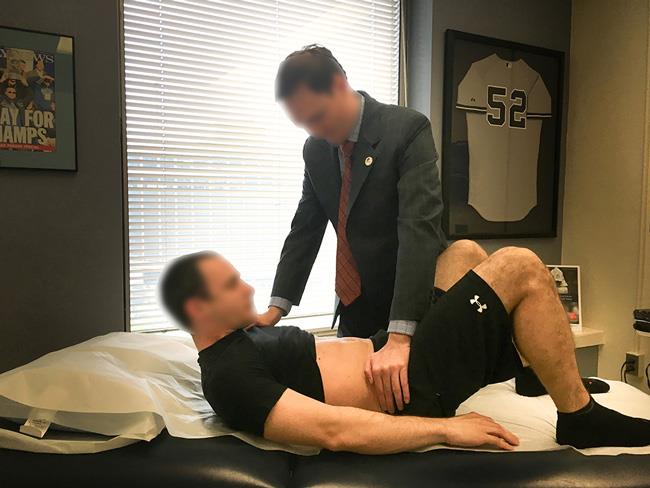Diseases & Conditions
Sports Hernia (Athletic Pubalgia)
A sports hernia is a painful, soft tissue injury that occurs in the groin area. It most often occurs during sports that require sudden changes of direction or intense twisting movements.
Although a sports hernia may lead to a traditional inguinal hernia, it is a different injury.
- Inguinal hernia (the most common type of groin hernia) is when abdominal tissue, such as part of the intestine, pushes through an opening in the lower abdominal wall, creating a painful bulge.
- Sports hernia is a strain or tear of any soft tissue (muscle, tendon, ligament) in the lower abdomen or groin area.
Because different tissues may be affected and a traditional hernia may not exist, the medical community prefers the term "athletic pubalgia" to refer to this type of injury. The general public and media are more familiar with "sports hernia," however, and this term will be used for the remainder of this article.
Anatomy
The soft tissues most frequently affected by sports hernia are the oblique muscles in the lower abdomen. Especially vulnerable are the tendons that attach the oblique muscles to the pubic bone. In many cases of sports hernia, the tendons that attach the thigh muscles to the pubic bone (adductors) are also stretched or torn.
Cause
Sports activities that involve planting the feet and twisting with maximum exertion can cause a tear in the soft tissue of the lower abdomen or groin.
Sports hernias occur mainly in vigorous sports such as ice hockey, soccer, wrestling, and football.
Symptoms
A sports hernia will usually cause severe pain in the groin area at the time of the injury. The pain typically gets better with rest but comes back when you return to sports activity, especially with twisting movements.
A sports hernia does not cause a visible bulge in the groin, like the more common inguinal hernia does. Over time, a sports hernia may lead to an inguinal hernia, and abdominal organs may press against the weakened soft tissues to form a visible bulge.
Without treatment, this injury can result in chronic, disabling pain that prevents you from resuming sports activities.
Doctor Examination
During your first appointment, your doctor will talk to you about your symptoms and how the injury occurred.
If you have a sports hernia, when your doctor does a physical examination, they will likely find tenderness in the groin or above the pubis. Although a sports hernia may be associated with a traditional inguinal hernia, in most cases, no hernia can be found by the doctor during a physical examination.
Physical Tests
To help determine whether you have a sports hernia, your doctor will likely ask you to do a sit-up or flex your trunk (torso) against resistance. If you have a sports hernia, these tests will be painful.
Imaging Tests
After your doctor completes a thorough exam, they may order X-rays or magnetic resonance imaging (MRI) scans to help determine whether you have a sports hernia.
Occasionally, bone scans or other tests are recommended to rule out other possible causes of the pain.
Treatment
Nonsurgical Treatment
Rest. In the first 7 to 10 days after the injury, treatment with rest and ice can be helpful. If you have a bulge in the groin, compression or a wrap may help relieve painful symptoms.
Physical therapy. Two weeks after your injury, you may begin to do physical therapy exercises to improve strength and flexibility in your abdominal and inner thigh muscles.
Anti-inflammatory medications. Your doctor may recommend non-steroidal anti-inflammatory drugs (NSAIDs), like ibuprofen or naproxen, to reduce swelling and pain.
In many cases, 4 to 6 weeks of physical therapy will resolve any pain and allow an athlete to return to sports. If, however, the pain comes back when you resume sports activities, you may need to consider surgery to repair the torn tissues.
Surgical Treatment
Surgical procedure. Surgery to repair the torn tissues in the groin can be done as:
- A traditional, open procedure with one long incision.
- An endoscopic procedure. In an endoscopy, the surgeon makes smaller skin incisions and uses a small camera, called an endoscope, to see inside the abdomen.
The end results of traditional and endoscopic procedures are the same.
Some cases of sports hernia require cutting of a small nerve in the groin (inguinal nerve) during the surgery to relieve the patient's pain. This procedure is called an inguinal neurectomy.
Your doctor will discuss the surgical procedure that best meets your needs.
Surgical rehabilitation. Your doctor will develop a rehabilitation plan to help you regain strength and endurance. Most athletes are able to return to sports 6 to 12 weeks after surgery.
Surgical outcomes. More than 90% of patients who go through nonsurgical treatment and then surgery are able to return to sports activity. In some patients, the tissues will tear again during sports, and the surgical repair will need to be repeated.
Additional surgery. In some cases of sports hernia, pain in the inner thigh continues after surgery. Your surgeon may recommend an additional surgery, called adductor tenotomy, to address this pain. In this procedure, the surgeon cuts the tendon that attaches the inner thigh muscles to the pubis. The tendon will heal at a greater length, releasing tension and giving the patient a greater range of motion.
Last Reviewed
June 2022
Contributed and/or Updated by
Peer-Reviewed by
AAOS does not endorse any treatments, procedures, products, or physicians referenced herein. This information is provided as an educational service and is not intended to serve as medical advice. Anyone seeking specific orthopaedic advice or assistance should consult his or her orthopaedic surgeon, or locate one in your area through the AAOS Find an Orthopaedist program on this website.









